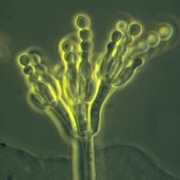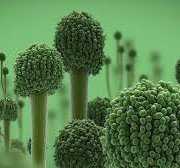Toxic Mold in Public Housing Units
Rio Arriba County officials claim their low-income public housing units do not have toxic mold despite County-commissioned lab tests identifying at least four mold species listed by the federal government as species of particular concern in four units.
“Toxic mold was not evident,” County Public Housing Director Angie Pacheco told County Commission Chairman Elias Coriz at a May 28 Public Housing Board meeting. “There were no signs of mold at all in (James) McConnell’s unit. The inspector found black mildew on windows in the other two units (inspected).”
James McConnell and Suzanne Tattan live in unit 110 of the Ojo Caliente low-income housing development. They fell ill with swollen eyes, flu-like symptoms and respiratory problems two days after moving in, according to a lawsuit the couple filed May 27 in federal District Court.
The Authority is seeking to evict McConnell and Tattan because of McConnell’s allegedly aggressive and harassing behavior when confronting Housing employees about his health concerns regarding the mold.
“A certified person found no mold,” Coriz told McConnell at the Housing Board meeting. “We tried to make sure that mold is indeed not happening. I don’t want people living in mold so I gave a very serious directive (to Pacheco).”
Coriz backtracked somewhat when McConnell produced photographs of dense growths of mold from behind his unit’s bedroom wallboard.
“We’ll definitely have to revisit the testing,” Coriz said. “But currently, we have the problem that I don’t have any documentation that there is mold. We took direction from Ms. Pacheco and the report came back negative. There’s no mold until it’s proven otherwise.” But the County’s own lab results show that the tests for mold were not “negative.”
The Authority paid Rio Rancho-based Rhoades Environmental $1,900 to test for mold (fungus) in three Ojo Caliente housing units — units 103, 110 and 112 — and in Tierra Amarilla housing unit 119, County documents show.
Lab reports dated May 17 showed that all four units had species of mold — Penicillium, Aspergillus and Cladosporium — listed by the Agency as “species of particular concern.”
Exposure to these species can cause nasal congestion, runny nose, sneezing, conjunctivitis, lacrimation, wheezing, chest tightness, and shortness of breath, according to the Agency’s web site.
“Among patients studied, children are the most sensitive to mold allergens,” the Agency web site states.
There are currently no federal regulations governing mold exposures and different people have different sensitivities to toxic molds, according to the lab report. The lab reports state that different individuals have different sensitivities to molds and that the only existing state standards for exposure levels, in New York and California, are being challenged in court on that basis.
The airborne mold levels in all four units are below a New York state mold exposure limits, according to the lab reports. The report does not state whether the mold in the units meets the California standard.
Lab reports for other County public housing units reported higher airborne and surface spore counts than those found in unit 110, where McConnell and Tattan live.
“The spore counts that came back are very, very low,” Pacheco said.
But that’s misleading, McConnell suggested.
It’s not surprising that levels in unit 110 were low because McConnell and Tattan went to extraordinary lengths to clean unit 110 of mold after they fell ill, McConnell said.
“We cleaned the entire house, stopped using the heater, taped over the air vents,” McConnell said.
The Authority also provided McConnell and Tattan with an air dehumidifier and space heaters in March, Pacheco confirmed.
The presence of airborne mold in unit 110 despite McConnell and Tattan’s cleaning efforts and the presence of an air dehumidifier were not reasons to suspect a toxic mold infestation, Pacheco said.
Pacheco did not ask Rhoades whether cleaning and the presence of an air dehumidifier could cause an underestimation of the amount of mold growing in the house, she said.
“We found species but the species were nontoxic,” Pacheco initially said Monday. “We didn’t feel like we needed to ask (Rhoades) anything.”
After reviewing the lab reports on Monday, she said that even if they were potentially toxic species, they’re not toxic at the reported levels.
“They’re molds but they’re not toxic at these levels,” Pacheco said. “If Rhoades had said there was mold in there, we’d have removed everyone and tested the entire complex.”
But Pacheco subsequently said only a doctor can determine whether a given level of potentially toxic mold exposure is dangerous to a particular person.
“I do believe these are nontoxic levels of mold,” Pacheco said. “My understanding from Rhoades is it’s not a hazard to health.”
Ron Rhoades, who wrote the lab reports, could not be reached for comment Tuesday.
The mold growths window sills in Ojo Caliente units 103 and 112, dismissed as “mildew” by Pacheco, turned out to be dense growths of toxic mold species, the lab report shows. The window sill growths in unit 112 showed Aspergillus and Penicillium, as well as Alternaria, another mold species of particular concern, according to the Agency web site.
County housing unit 119 in Tierra Amarilla had Aspergillus and Penicillium in the dining room, the lab reports show.
Pacheco found two other Ojo Caliente units with “mildew” when she inspected all of the County’s public housing units in 2006, she said. She did not remember which units those were.
When black stains have been encountered in units by Authority staff, they’ve assumed it to be harmless mildew, Pacheco said.
“We’re just basing it on what we assume,” Pacheco said. “We assume it’s mildew.”
Coriz said he had depended on Pacheco’s description of lab results rather than the lab reports themselves.
The County plans to have all the units retested for mold but the details have not been worked out, County Manager Lorenzo Valdez said. The question is not whether the species found are potentially toxic but whether the levels in the units are low enough to be safe, Coriz said. He also expressed concern that by opening drywall to expose mold behind the walls, McConnell may have placed himself and Tattan at risk.
“By McConnell opening up the wall, it’s a whole different animal now,” Coriz said. “When it was in the wall, it wasn’t exposed. Rhoades did the test when the walls were closed up. He’ll have to go back and do a new test. I hear they’re still in the apartment so I don’t know to what extent they’ve exposed themselves to the mold now. It might be toxic now. We want them out for their own safety.”
The couple had not been evicted as of Tuesday.








